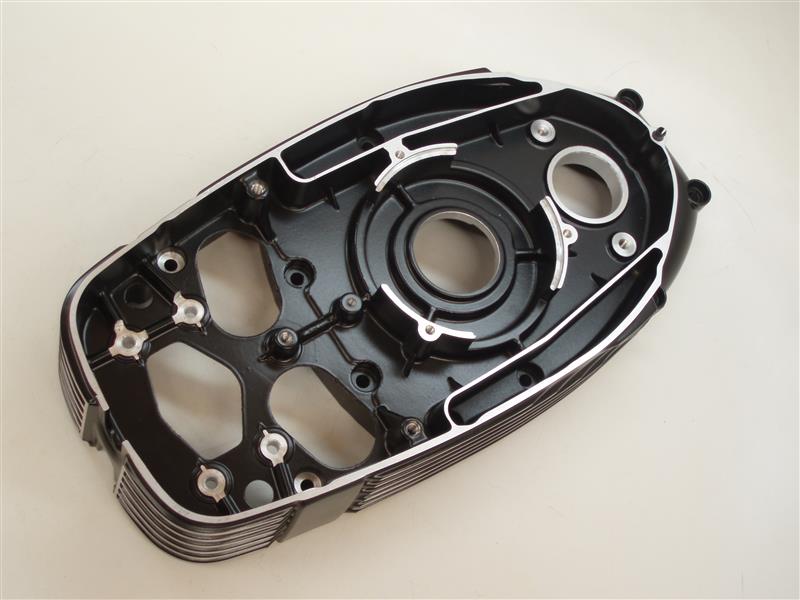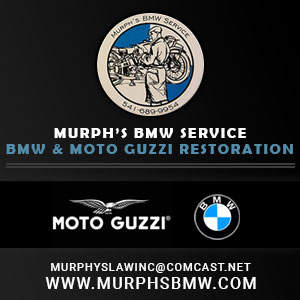'80 BMW R100T: Runin' Lean
I'm pretty new to BMW Airhead maintenance. Purchased a 1980 BMW R100T off e-Bay a few years back and I've been restoring it ever since. Lots of time, money and research spent.
I took my bike down to Quality Cycle Service in Tonto Basin, AZ, ( http://qualitycycleservice.com ) for the last of the engine work and to make sure everything I did was correct.
I had Dave install:
* New MAC deep oil pan, ( https://shop.macperformance.com/MAC-BMW-Twins-1970-1989-Large-Oil-Sump-Pan-98101.htm ) No modification to the center stand needed.
* New Siebenrock replacement kit. New cylinders and pistons , https://www.siebenrock.com/en/engine-parts/replacement-kit/3018/replacement-kit-1000cc-99mm?c=618
* Cylinder heads rebuilt by Ted Porter's BeemerShop, ( https://www.beemershop.com/category/airhead-cylinder-head-page.html )
* New timing cover, from MaxBMW,  .
.
Since I bought the bike off e-Bay and not being familiar with Airheads, I asked Dave to check everything out. And get it running correctly, up to speed.
Anyway, I got my bike back and the bottom exhaust manifold pipe was all blue. I asked him about it when I picked-up the bike and he said I need to change a jet in the carburetor/s.
I was exhausted driving down from Las Vegas and didn't put two & two together and ask him why didn't he didn't adjust the carburetors? After all that's what I was paying $1600 for. To get my bike running right.
So now I'm stuck with figuring out what needs to be done to get my carbs running correctly.
* My first question is, how can I tell if the lean problem is occurring at idle, or at speed? Or both?
* I understand the fuel/air mixture screw on the bottom of the carbs is for adjusting the mixture at idle. And only effects the idle mixture.
* I also understand the internal jets are for adjusting the fuel mixture at speed.
* So, is there an easy way to tell which one is my lean problem, causing the blueing? At Idle, at speed, or both?
My bike seems to run so-so, but that I assume is to be until the new parts, valves and pistons break in. Dave said around 350 miles.
Any help, ideas, would be greatly appricated.
First things first. Welcome to Airheads and I'm sorry to hear you're having this issue.
The second important thing is NOT to jump to conclusions. Blue pipes are in indication of heat, but that can be brought on by many, many different causes. Let's resist running down the "my carbs are bad" trail until it's based on something more than a 2 minute conversation, with a mechanic whom you may now distrust.
Third thing to remember is that you are riding a vintage vehicle. You must adopt the same mindset as if you owned a Model T or a 1940's John Deere tractor. The true mechanics that worked on these back in the day are retired or dead. While you can find many people to bolt on mechanical items, you must assume ultimate responsibility. Therefore, at the outset, let's agree on one simple idea: If you ever want this bike to run correctly again, then you're going to need to get your hands dirty. Reading about it and then paying other people to care is going to do only one thing: make you poor. This is the harsh, but realistic fact before you.
On To Your Issue
Still with us ? I hope so. Fuel, ignition, and a whole raft of other conditions can create heat. Carb prep is at the very end of a long line of other adjustments that must be made BEFORE any successful carb adjustments or repairs can be made.
• First of all, read this... https://www.airheads.org/forum/technical-discussions/992-new-owner-primer-tips-to-get-your-airhead-back-on-the-road
"But that's for people bringing a bike out of storage", you say. And I say, if you haven't ridden this bike in the last 2 months, then that's exactly what you're doing.
• Your fuel: Is it over 6 weeks old ? If so get rid of it. Your car will do fine with it, but your motorcycle won't. Your car has computerized ignition timing and fuel injection that accounts for varying grades of fuel, but your vintage motorcycle decidedly does not. So never let what your car is doing color your ideas about your Airhead. You'll want "high test" fuel from a name brand outlet... and you must get something like Shell or Chevron that has the built-in cleaners.
• Then replace the plugs, plug wires (metal core wires ONLY) and plug caps (5K Ohm only).
• The set the ignition timing with a strobe lamp using the flywheel "F" mark (or however high-engine speed it marked on your model). This timing mark should be achieved at 5000 RPM as indicated on the tach.
• Then investigate the complete air intake system beginning with the Starter Cover, if you have the intake with metal covers. Or starting with the air filter cover if you have the plastic dual snout air filter housing. Replace the air filter either way and inspect the entire cavity for obstructions.
• Finally, pop off the float bowls and look for signs of ethanol clogging. Do you see a brownish coating in the bottom of the bowl ? That's caused by allowing fuel to sit in the carbs. You can't do that with today's fuels.

• Whether you see it as thick as it appears in the photo, we want to start with replacing the Low Speed jet, the Needle Jet, and the carb Needle on both sides. If you haven't already you'll need the latest Ethanol-proof Floats and Float Needles too. Inspect the Diaphragms for holes of any size or shape. Ethanol will eat the older ones up too. Replace the 2 intake hoses if they are over 10 years old. And while the hoses are off, make sure the intake spigots in the cyl head are tight.
That should keep you sufficiently self-quarantined for the next month or more. 😛 When you get all that correct, then we can start the jetting process if needed. If you have questions, just ask.
Hope this helps.
Owning an old Airhead is easy.
Keeping an old Airhead running great is the true test.
Thanks for the reply Wobbly, I appreciate your suggestions. Actually I've done a lot of work on my bike, yes, turned my own wrenches. My bike was running pretty good when I took it down to Quality Cycle Service for some upgrades.
I'm somewhat familure with vintage motorcycles. I bought my first motorcycle a 1971 Triumph in 1972.
I had put around 350 miles on my bike since I finished my part of the restoration. My exhaust pipes were lightly blued. Now they are a dark blue! At least the bottom cross-connect pipe.
Things I wanted done:
* I wanted the heads rebuilt by Ted Porter.
* I wanted new Seibenrock pistons and cylinders installed.
* I wanted a new MAC deep oilpan installed.
Things I did:
* My gas was new, "premium".
* My carbs were freshly rebuilt by BING USA.
* Brand new spark plugs, Bosch W5DC. Dave replace my plugs with new NGK BP7ES plugs.
*I had installed brand new NGK 5K spark plug wires. I measured them with an OHM meter.
I haven't checked the timing, but I assume Dave who's been working on Airheads for 35 years set it correctly.
Since you brought up spark plugs, I decided to pull mine and check them. They are BLACK with carbon! (See attached photo).
This make me think the engine is running rich, not lean??? Or the new pistons aren't seated and are letting some oil pass by.
Now I'm really confused.
I bought my first motorcycle a 1971 Triumph in 1972.
Hmmm. Small world. I was working at a Triumph dealership in 1971/72.
I had installed brand new NGK 5K spark plug wires. I measured them with an OHM meter.
The wires should be ZERO Ohm metal core wires. The caps should be 5K Ohm.
Since you brought up spark plugs, I decided to pull mine and check them. They are BLACK with carbon! This make me think the engine is running rich, not lean??? Or the new pistons aren't seated and are letting some oil pass by. Now I'm really confused.
Those plugs definitely tell me we have 2 things...
• A mechanic that doesn't know how to install spark plugs properly. It's very bad practice to install a plug into an air cooled engine without some form of anti-seize, grease, or even engine oil on the threads. 1 in every 1000 plugs will seize in the threads and destroy the head when the plug is pulled. It's so inexpensive to prevent this from happening that this practice is mandatory.
• An owner who doesn't know how to read spark plugs. There are 4 stages of jetting in a Bing, so you need to ride several miles at a fixed throttle opening in a specific jet range until the plug has color and then abruptly stop the engine dead. Then you can read the plug for that specific jet. You can't ride the bike back to the shop, let it idle for God knows how long, and then decide to pull the plug and get any meaningful information.
All the best.
Owning an old Airhead is easy.
Keeping an old Airhead running great is the true test.
My cables and caps were already assembled when I bought them. I measured from the connector inside the cap to the connector on the other end, 5K!
What do think about my spark plugs? What spark plug do you think I should be using?
I have 5, 6, and 7 series spark plugs available.
My cables and caps were already assembled when I bought them. I measured from the connector inside the cap to the connector on the other end, 5K!
Brought them from ? A Chinese importer, Motorrad Elecktrik or ??
What do think about my spark plugs? What spark plug do you think I should be using? I have 5, 6, and 7 series spark plugs available.
I think you should use the plug NGK or Bosch says is correct for the engine. We don't change spark plug heat ranges on a whim.
Owning an old Airhead is easy.
Keeping an old Airhead running great is the true test.
A few observations;
1) The sooty plugs indicate to me that there is a running rich condition in play.
2) My own experience is that the exhaust header turns blue right down to the crossover position and not much further.
3) My guess would be that un-burned air/fuel in the exhaust is being scavenged from one side to the other and heating up the crossover.
If you do not have a copy of the Bing carburetor manual it would be the second best investment you can make in maintaining your motorcycle, #1 being joining the Airheads.
If the enrichers (choke) are not completely closed when the motor is fully warmed up, they will allow excess fuel to be delivered in all RPM ranges. If your model has the choke lever on the handle bars, that system provides a few different opportunities for the enrichers to not close all the way. As an example, my 1985 R80RT had almost everything wrong that could go wrong with this assembly yet the bike would run O.K. Frayed cables, stretched out return springs, and rust inside the 1 into 2 cable sleeve under the fuel tank. If your bike has the choke lever on the side of the aluminum air filter box, it is still worthwhile to confirm that the enrichers close all the way. That early system has fewer weak links. If Bing rebuilt your carburetors, they should be as good as they can be.
former Airmarshal, IL.
A few observations;
1) The sooty plugs indicate to me that there is a running rich condition in play.
2) My own experience is that the exhaust header turns blue right down to the crossover position and not much further.
3) My guess would be that un-burned air/fuel in the exhaust is being scavenged from one side to the other and heating up the crossover.
If you do not have a copy of the Bing carburetor manual it would be the second best investment you can make in maintaining your motorcycle, #1 being joining the Airheads.
If the enrichers (choke) are not completely closed when the motor is fully warmed up, they will allow excess fuel to be delivered in all RPM ranges. If your model has the choke lever on the handle bars, that system provides a few different opportunities for the enrichers to not close all the way. As an example, my 1985 R80RT had almost everything wrong that could go wrong with this assembly yet the bike would run O.K. Frayed cables, stretched out return springs, and rust inside the 1 into 2 cable sleeve under the fuel tank. If your bike has the choke lever on the side of the aluminum air filter box, it is still worthwhile to confirm that the enrichers close all the way. That early system has fewer weak links. If Bing rebuilt your carburetors, they should be as good as they can be.
former Airmarshal, IL.
A few observations;
1) The sooty plugs indicate to me that there is a running rich condition in play.
2) My own experience is that the exhaust header turns blue right down to the crossover position and not much further.
3) My guess would be that un-burned air/fuel in the exhaust is being scavenged from one side to the other and heating up the crossover.
If you do not have a copy of the Bing carburetor manual it would be the second best investment you can make in maintaining your motorcycle, #1 being joining the Airheads.
If the enrichers (choke) are not completely closed when the motor is fully warmed up, they will allow excess fuel to be delivered in all RPM ranges. If your model has the choke lever on the handle bars, that system provides a few different opportunities for the enrichers to not close all the way. As an example, my 1985 R80RT had almost everything wrong that could go wrong with this assembly yet the bike would run O.K. Frayed cables, stretched out return springs, and rust inside the 1 into 2 cable sleeve under the fuel tank. If your bike has the choke lever on the side of the aluminum air filter box, it is still worthwhile to confirm that the enrichers close all the way. That early system has fewer weak links. If Bing rebuilt your carburetors, they should be as good as they can be.
former Airmarshal, IL.
I also have a 1980 R100T.
My question is how is the bike running?
What is the idle rpm?
There is a nice algorithm in getting these bikes to run as intended.. and once set typically require little changes unless you perform some major work (as you have).
Was your post triggered by the blue discoloration of your pipes?
I have had great success with your current plugs (NGK).
Please grab yourself a copy of the Clymers manual - has saved me some strife.
Chris Brackney
* Pre-made 5K NGK wires from Motorrad Elecktrik.
* As far as the spark plugs go, there-in lies the problem. Different websites, different retailers, all say something different. Where can I go to find out the truth for my bike, a 1980 R100T?
Any ideas, a website please? Thanks...
Oh, I just balanced my carbs and I noticed backfire, what does that indicate?
NGK BP7ES is what's indicated.
Owning an old Airhead is easy.
Keeping an old Airhead running great is the true test.
- 27 Forums
- 1,801 Topics
- 10.2 K Posts
- 3 Online
- 5,524 Members





